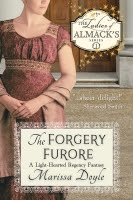Lilacs are a lovely flower—the scent, the color, the way they hang like plump grapes. It was a love of flowers and growing things in general that led this nineteenth century heroine to become a renowned hybridizer, developing more than 14 varieties of lilacs still treasured around the world.
Hulda Klager was born in 1863 in Germany. She was a toddler when her family immigrated to America, eventually settling in Woodland, Washington, about a half hour north of Portland, Oregon, along the I-5 corridor. They owned a farm, and Hulda grew up to marry a farmer. After reading a book by Luther Burbank about hybridizing and decided to experiment with apples. She hated having to peel so many of them to make a pie. She crossed a Wolf River apple with a Bismark and discovered a larger, delicious apple. She tried dahlias and roses as well. A couple years later, she started working with lilacs, developing deeper colors, bigger blooms, more hardy plants. By 1910, she had 14 commercial varieties to her credit, though at one time she had named as many as 100.
 In 1920, she began opening her home and gardens each spring to share her lilacs with others. Her open houses were so beloved that towns around the area requested that she name new varieties after them, including the City of Longview, City of Kalama, City of Gresham, and City of Woodland. She was honored by Washington State and Harvard, among others, for her work. The death of her husband in 1922 made her rethink her work, but her family encouraged her to continue.
In 1920, she began opening her home and gardens each spring to share her lilacs with others. Her open houses were so beloved that towns around the area requested that she name new varieties after them, including the City of Longview, City of Kalama, City of Gresham, and City of Woodland. She was honored by Washington State and Harvard, among others, for her work. The death of her husband in 1922 made her rethink her work, but her family encouraged her to continue. What happened next is best told in the words of the website dedicated to her work:
 “The spring of 1948 brought another great adversity when the swirling waters of the Columbia River swept across her property, wiping out her lilac gardens and nearly every other shrub on the place. Only the big trees withstood the flood but undaunted and at the age of 83, she set about rebuilding her garden. Many people who had purchased her lilacs in the past returned starts to her so she could replace her losses.
“The spring of 1948 brought another great adversity when the swirling waters of the Columbia River swept across her property, wiping out her lilac gardens and nearly every other shrub on the place. Only the big trees withstood the flood but undaunted and at the age of 83, she set about rebuilding her garden. Many people who had purchased her lilacs in the past returned starts to her so she could replace her losses.It took two years and a great deal of work but in 1950 she was able to open her gardens for Lilac Week once again — a practice she continued until her death in 1960.”
The seeds Hulda planted continue to bear fruit. Now a state and national historic landmark, Hulda Klager’s home and gardens continue to open each spring to share her legacy. Her life forms the basis for Jane Kirkpatrick’s Where Lilacs Still Bloom.






2 comments:
My mom loves lilacs. They make my nose itch. Even so, I wouldn't have wanted Hulda Klager's life's work, which is undoubtedly amazing, to be bulldozed over for an industrial site! What a crime that would have been. Thank goodness her garden was preserved. The photos are lovely.
I agree, QNPoohBear. I didn't go into it in the blog, so I'm glad you looked into it further. The ladies of the Lilac Society give tirelessly to keep up the place and open it to people each year. I was fortunate to visit with my mother this year, and it was impressive. Hats off to them!
Post a Comment